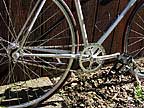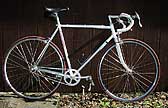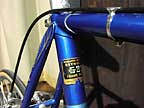Cyclofiend.com:
Notes: Fixed Gear Testimonial![]()
Your
donation helps to support this site and its upkeep.
|
Bicycling creates ever-growing groups of people who have not only arrived at the arcane of the obscure, but seem to revel in it. Through both direct action and subliminal activities, they continually recruit more members. The degrees of challenge become finer, and to an outsider, increasingly odd... That is more or less the thought I had while looking in the mirror, wondering just exactly when I became a bib-wearing, wool jersey-touting cyclist who was about to head onto the roadways on a bike with a drive system that was cutting edge in 1910. I had paused to ponder what route was best taken on a bike that wouldn't allow coasting, and found myself wondering about the path that brought me to that point. Though I would like to blame Sheldon Brown directly, he was really only the catalyst to this process. Whatever allowed this idea of ceaseless pedaling to seem attractive may have been deeply planted, but it didn't take much to coax it to bloom. For a long time, I'd heard rumors of the "track" bikes. Lurid stories presented imagery of knees being popped out of joints, and unwilling cyclists being rag-dolled by the never-ceasing movements of the cranks. Gristly pops and horrendous pedal/shin whacks seemed a repeated thread. Young track riders warned me NEVER to cut up a steep bank on a fixed-gear. A friend told how he and some buddies made sport of encouraging anyone who seemed interested to take his track bike for a spin -- with no instruction and hearty enthusiasm. Many people started out just fine, but most found themselves pitched off with a lusty heave-ho at the first stop sign just up the block. But, I would also read about the old days, when the serious riders spent winter months rolling over miles on a fixed gear bike, gaining a smooth spin and incredible leg speed. Somewhere between those opposing ideas, a nagging thought gathered force: I was not really a complete cyclist until I could ride such a bicycle. Researching some other topics, I'd found Sheldon's website essays on this practice, which demystified things further. The bad imagery abated as some ideas and experiences grounded in reality replaced the street corner "facts of life." The allure of such simplicity tantalized me. It would force me to shut up and pedal harder. I'd previously cobbled together a single speed mountain bike and enjoyed the challenge on the trails. I could get my mind around just one gear. It was the idea of constant pedaling which caused hesitation. Momentum began when I saw an old Panasonic frame heading to the dumpster. Cables cut, and generally picked over for spare bits, the lugged frame with Tange tubes was the losing part of a big cleanup project at a shop. Though greasy and neglected, a free frame that fit was too much of a sign to ignore. It also possessed a nice unbent set of horizontal rear dropouts, complete with adjusters. Most of the needed add-on bits had lived in my various parts bins and boxes - save for the beautifully polished Suntour brakes that Rivendell sold me, a wonderfully unused short armed (165 mm) old-style Shimano 600 crankset found hidden in a very dusty bin at the local Recyclery, and of course, the Suzue/Mavic wheel, sprocket and the necessary lockring found through Sheldon Brown/Harris Cyclery. Simply moving the chainring to the outside of the spider created an exquisite chainline. With the hills around the greater San Francisco Bay Area, it struck me that until I proved otherwise, front and rear brakes were OK for my first fixed gear project. My wife took this as a sign that part of my sanity still remained intact. Everything went on remarkably easily - no derailers to mount or cables to tension - although a slight hiccup occurred as the project reached completion. All the bits were on, but when I strung the chain through the 42T chainring and the 15T sprocket, it became clear that the dimensions of the frame would cause too short a chain - putting the axle at the absolute tip of the dropouts, or too long - preventing adequate tension even with the wheel pulled all the way back against the dropout adjusters. Despite losing what I thought might be more precise adjustment of the rear wheel tension, I removed the adjusters, got the extra nudge backwards and checked the tension at various points in the rotation. Nothing loose, nothing binding. I found myself out of excuses. So, that very night, I slapped on a helmet and headed up the neighborhood streets under a crisp full February moon, feet strapped directly to pedals driving the wheel... ...and I made it home in one piece. There had been a couple "wha-tha-fa" moments when I first eased up a touch on the top of the pedal stroke in a turn, and another when I began to rise off the saddle as I bumped up the driveway. Nothing disastrous occurred, but there had been the sudden and unexpected experience of getting pushed quickly forward by the pedals. But, the ride. The RIDE! - a revelation of smooth and silent movement. Not a click of freewheel, snicker of shifting chain nor even the mildest rattle of a shifter part marred the swooping path through the moonlit streets. Something rather exciting had revealed itself.
My most immediate fear had been of catching a pedal and finding myself a couple feet above my bike and the pavement. (As they say, it isn't the fall that does the damage, rather the sudden stop. ) Luckily the rather long ends of the toe clip straps acted as a "curb-feeler." Hearing the scrape of the plastic end tabs lightly kissing asphalt, I'd know that was about where to hold the lean angle. My speed increased. When a car pulled in front of me, I found out that two brakes combined with a direct-drive rear wheel stops a bicycle on level, dry pavement pretty much "right now". If I wore dentures, they would've needed the road dust cleaned off of them. The first downhill was a somewhat twisty bit of roadway a few miles from the house. As gravity took over, things started happening pretty quickly, sort of like a Dick Dale guitar solo fueled by a few strong espressos. I concentrated on remaining calm and relaxed as my pedal cadence increased and the road continued to curve. This was a counter-intuitive act -- no more lazy dipping of the outside pedal and howling through the turn like the freewheel bikes let you get away with. Someone who rode a motorcycle had told me that the more you lean, the less the bike has to. Luckily, this thought burbled up from my subconscious as the road continued descending. Keeping the bike a bit more upright, I relaxed enough to lean my torso while my legs played eggbeater. As the weeks progressed and the weather warmed, the fixed got pulled down from the rack more frequently for errands, commuting, and finally, after slapping some new-fangled clip-em-in road pedals into place, for some decent mileage . When my multi-geared road bike became a bit cantankerous, (and it did deserve a new set of cables and housing at the least, and probably needed to retire a shifter), it got shuttled to the back of the rack for a rainy day project - a reasonably unlikely event in California after March. A while later, I realized the only bicycle I'd been riding during the previous four or five weeks was the fixed gear. It had became great sport to ride along with folks and see how long it took them to realize I was riding a fixed gear. I'd begun referring to those who rode freewheel bikes as "coasters". And curiously enough, I actually began to look forward to the odd stoplight, as a long red was the only opportunity to stop pedaling while riding. Multi-geared "coastables" began to feel foreign. They simply didn't feel connected or smooth anymore. The more miles on the Panasonic, the more enjoyable it became. In fact, despite the claims that you worked harder, there were situations where it was simply easier to ride a fixed system. In my case, I'm being pushed by a 200 pound flywheel. Strange as it may sound, this allows you to loaf along with the momentum. It feels as though you just add a nudge of power to each pedal stroke. The fixed gear is more like a early machine-age dynamo - you roll it up to speed and pretty much rumble along. Of course, such acceleration requires a high level of commitment. Once you've jammed up to traffic flow speed on a slight downhill, you aren't going to be able to just coast along and shave speed with the hand brakes. It works the other way as well -- I have never been passed so suddenly by another rider on a hill as when I've misjudged the momentum necessary to get me over the top with 70-odd inches of gear beneath me. Eventually, I did actually begin to ride my geared and freewheeled bikes again, but by that point freewheeling had become an oddity. A quick pang of panic shot through me the first time I stopped pedaling while the bike was moving. Before riding the fixed, I could only theoretically conceive of putting back-pressure on the pedals. Now, something feels wrong if it's not there. Those coastable bikes have such dinky little gears that it doesn't seem fair . But, it also seems that there are a couple more "gears" in my arsenal, without actually changing the position of the chain on the cogs. Yeah, other stuff you've heard is true, too - track stands become a cinch, drivetrain wear becomes a much more theoretical topic, and if you stop pedaling, the fixed gear will remind you. But, the looser you ride, the more of a gentle nudge it seems. Epilog: The Infection Spreads
Unlike freewheel bikes, getting up to speed is only the beginning. This seems to be true not only of the biomechanical aspect of pedaling the fixed gear, but concerning the practice as a whole. You'll see. © 2005, Jim Edgar
|
||
|
|
||
| Current Classics Gallery | Cross Bike Gallery | |
| Single Speed Garage | Working
Bikes & Practical Hardware |
|
Grand Tour Daily Reports - Coffee-fueled updates
-- Click here to subscribe to Cyclofiend.com Daily Updates! --
Tour Reports :
2002 Giro D'Italia - 2002 Tour de France
Photo Pages:
Cyclocross
Nationals - 2002
- San
Francisco Grand Prix Road Race - 2002
- San
Francisco Grand Prix - 2001
Cyclocross
Nationals - 1999 - Men's
Elite - Women's Elite
- Other Photos
Some Photos from 1998 SuperCross -
 "How
I Learned To Stop Coasting And Love The Spin"
"How
I Learned To Stop Coasting And Love The Spin"  The
next day, I decided to venture further, planning to reduce the variables
of this wacky equation to the absolute minimum and focus on the
riding technique. With nonexistent fixed gear skills, seclusion
seemed key - roadways with little auto traffic, a generally good
line of sight at all times and blessedly pancake flat. Sure enough,
by about the third corner, a "lazy leg" tendency showed up -- I'd
begin to ease up my foot pressure and position my off-side foot
at the traditional 9 o'clock position. A fixed gear system will
not put up with that type of nonsense, and forward momentum immediately
snapped me right over into the next pedal stroke. At that point
I really, really thanked those who had encouraged me to use shorter
crank arms.
The
next day, I decided to venture further, planning to reduce the variables
of this wacky equation to the absolute minimum and focus on the
riding technique. With nonexistent fixed gear skills, seclusion
seemed key - roadways with little auto traffic, a generally good
line of sight at all times and blessedly pancake flat. Sure enough,
by about the third corner, a "lazy leg" tendency showed up -- I'd
begin to ease up my foot pressure and position my off-side foot
at the traditional 9 o'clock position. A fixed gear system will
not put up with that type of nonsense, and forward momentum immediately
snapped me right over into the next pedal stroke. At that point
I really, really thanked those who had encouraged me to use shorter
crank arms.  At
a garage sale, I came across a forgotten Dawes with a 531 lugged
steel frame and fork. Since the price had been ridiculously low,
I had planned on fixing it up and selling it off. But, as I stripped
it down and cleaned it off, another idea began to form. Unlike the
Panasonic, it had eyelets and plenty of clearance for fenders. So,
the Dawes began looking like a nice errand & commute bike option.
Clearly, in the interest of reliability, it ought to be a fixed
gear...
At
a garage sale, I came across a forgotten Dawes with a 531 lugged
steel frame and fork. Since the price had been ridiculously low,
I had planned on fixing it up and selling it off. But, as I stripped
it down and cleaned it off, another idea began to form. Unlike the
Panasonic, it had eyelets and plenty of clearance for fenders. So,
the Dawes began looking like a nice errand & commute bike option.
Clearly, in the interest of reliability, it ought to be a fixed
gear...